MSG Deep Dive part 2: How to Buy and Use MSG and MSG-less Flavor Enhancers
+ Say MSG 3 Ways in Vietnamese
Welcome to part 2 of our MSG mini series. You’re here because you’re curious about the much maligned but now seemingly benign flavor enhancer. Thanks to folks who added to last week’s MSG basics post via comments, which included Anjali’s story about mistaking MSG for salt in Japan. My dad was on a perpetual low-sodium diet and I’m sure my mom filled in the flavor gaps with MSG. Fathers influence us whether or not they’re still with us. We celebrate them in America today but the event is for dads everywhere. Happy Father’s Day!
When you’ve got a moment, let’s focus on MSG and its Asian flavor enhancing kin. That’s right. There are other options for amplifying flavor! Dive in and share your insights and experiences.
Monosodium glutamate (MSG) has existed for well over a century. It started out in Japan and then spread throughout Asia before going overseas. I’ll limit my discussions to Viet (and a smidgen of Chinese) foodways because I know them well.
MSG has been used in Vietnam for many years, and my mom says that Viet cooks were using the magic seasoning even before she was born in 1934. The government rationed the crystalline seasoning during food shortages. In the late 1970s, our family knew Viet expatriates who mailed MSG to struggling family members in Vietnam so they would have a precious item to sell or trade. MSG was currency.
We don’t have an MSG shortage in 2023, but nevertheless, my mother keeps a huge canister of Ac’cent in her cupboard. She slowly doles it out by refilling a small Mc Cormick(!) recycled spice jar. Note how she keeps a tiny tasting spoon for stealthily boosting flavor. Her food never tastes like MSG. It just tastes good.
What is MSG called in Vietnamese?
Get this — in Vietnam, a smallish country, MSG goes by three regional names:
bột ngọt (southern)
vị tinh (central)
mì chính (northern)
3 Ways to say MSG in Vietnamese
Why so many terms for one ingredient? We’re into MSG and self-determination! People love to be non-conformists. Of those three terms, bột ngọt is the one I grew up with. My parents are from northern and central Vietnam but ended up in Saigon to start their family. Viet people I meet mostly know MSG as bột ngọt. It literally means sweet powder, which seems appropriate because MSG imparts a nuanced, savory sweetness to food.
The other two regional terms — vị tinh and mì chính, are based upon Vietnamese pronunciations of the Chinese characters for MSG: 味 精 (taste + excellent/perfect/energy). In English those characters are often translated as “gourmet powder”. Chinese pronunciation of the characters vary by dialect, for example: wèijīng in Mandarin, mei zing in Cantonese, and vei jing in Jin. (You can detect the connection between the latter two Chinese terms with the central and northern Vietnamese terms for MSG.)
MSG vs MSG-Less Flavor Enhancers
Now here’s where things get more interesting. All this talk about MSG makes you think that MSG is the only game in town. In Vietnamese, MSG belongs to a bigger category of flavor enhancers (hạt nêm) that includes MSG-less seasoning granules.
Let’s first talk about three MSG options. I’ve mentioned Ac’cent sold at supermarkets, sometimes with a snazzier container than the canister shown here.
At Asian markets, you’ll find brands such as the ones in the photo below. Look at how Ajinomoto is clearly labeled as MSG. On the other hand, its Chinese rival is Ve-Tsin, a classic brand that isn’t clearly labeled as monosodium glutamate, but rather presented as “gourmet powder”, the Chinese term discussed earlier.
What’s the difference between Ajinomoto, Ac’cent, and Ve-Tsin? They are all MSG. Ajinomoto and Ac’cent are the same, but Ajinomoto is widely sold at Asian markets. Ac’cent is sold at mainstream supermarkets (don’t go looking for it at Whole Foods; head to a Kroger, Publix, or the like). Ajinomoto and Ac’cent have the same crystalline texture and can be used interchangeably.
Ve-Tsin is not so widely distributed. I purchased the charming tin at a Chinese market in North Carolina (it is sold online too). Ve-Tsin is finely textured like starch or powdered sugar. Comparing weight, Ve-Tsin weighs less than Ajinomoto or Ac’cent, which means 1/2 teaspoon of Ve-Tsin equals 1/4 teaspoon of Ajinomoto or Ac’cent.
Most English-language recipes call for MSG that’s crystalline because that’s the standard form. If you use Chinese Ve-Tsin (or a similarly powdery MSG), double the amount or use a scant double of what’s called for in the recipe. Think of powdery MSG as being like the Diamond Crystal Kosher salt (you double DCKS for fine sea salt) when doing the conversion:
roughly x2 powdery MSG = x1 crystalline MSG
What are Good MSG-less Substitutes?
Asian cooks like to zhuzh up dishes with flavor enhancers and over the years, there have been many MSG alternatives sold at Asian markets. If MSG is not for you, shop for Asian mushroom seasoning granules (AMSG). The beige seasoning granules are not the same as “umami mushroom powder” sold at Trader Joe’s, Whole Foods, and other mainstream retailers. Those mushroom powders are made from ground up mushroom and spices. They are great for certain preparations but lack the oomph of AMSG, which is formulated to yield results like regular MSG.
Note that in Ever-Green Vietnamese, I use “Asian mushroom seasoning granules” to deter cooks from using mushroom powder. Leading brands include Po Lo Ku and Imperial Taste mushroom seasoning. The typical packaging is mylar-like. I’ve also included the ingredients list. The fact that the label includes Chinese, English, and Vietnamese speaks volumes to their target market. AMSG is sold at most Chinese and Vietnamese markets as well as online. I’ve seen Po Lo Ku made in Taiwan and Singapore; both are good products but I don’t understand the location differences.
What’s the difference between MSG and Asian mushroom seasoning granules? Both amplify the flavors of food, but the beige ASMG granules cloud liquids and, depending on their taste, may overwhelm with mushroomy flavor (see the buying guide below). The granules do not dissolve as easily as MSG so you can’t simply sprinkle some onto a dish to finish the flavor. If you want to do that, pound AMSG or grind it up and keep it in a jar. You may use less because the powder is finer than the granules.
Crystalline MSG doesn’t cloud broths and plays well with other ingredients without taking over. I keep several flavor enhancers on hand but use MSG the most. What’s your preferred flavor enhancer?
How to Use MSG and Asian Mushroom Seasoning Granules?
A flavor enhancer is not a flavor replacer. It commingles with other ingredients well but it also has unique flavor properties of its own and can take over when overused. To build umami, I use MSG (or AMSG) along with salt, sugar, and other seasonings. Flavor-enhanced food ideally tastes fabulous but still like itself.
Because of weight differences, apply a 1-to-2 volume ratio of MSG to AMSG.
A teaspoon of flavor enhancer, whether MSG or AMSG, has a saltier hit than a teaspoon of salt. When experimenting, decrease the normal salt amount by about one-third and make up the difference by gradually adding MSG and tasting along the way.
Where to Shop for MSG?
For Ac’cent, peruse the spice section of mainstream grocers. It’s typically found on a mid-to-lower shelf. There is usually only one slot for it so I’ve often missed it.
For Asian brands of MSG, such as Ajinomoto brand, head to an East Asian (Chinese, Japanese, Korean or Vietnamese) market or a pan-Asian or international market. Ajinomoto has production facilities in the United States. The product labels say “product of U.S.A.”
Suggested brands recap:
MSG brands: Ac’cent and Ajinomoto are widely distributed at markets and online. While available online, Ve-Tsin is too much of an outlier because it’s not widely distributed and not the standard called for in many recipes.
Mushroom seasoning brands: Imperial Taste, Kinoko Yugo Fusion, Po Lo Ku (all sold at Asian markets and online). Kinoko Yugo Fusion has a strong shiitake flavor whereas Imperial Taste and Po Lo Ku are more neutral. When shopping for seasoning granules check the label carefully because some contain MSG.
Wait — What’s Up with Chicken and Mushroom Bouillon Powder?
Yup, they’re used in Asian kitchens as a flavor booster too. Sold at Asian markets, these products contain MSG. They’re great for when you need a little broth for say, a stir-fry or light soup. When a recipe calls for chicken or vegetable broth, you could try one of these. Or, try Better than Bouillon.
Some Asian recipes call for chicken bouillon powder as a seasoning. If that’s the case, you’re looking for a product like Lee Kum Kee’s. Bouillon powders function like a flavor enhancer because they’re loaded with glutamic acid.
One More Thing — What about Nutritional Yeast?
I keep nutritional yeast (nooch) in my kitchen but compared to MSG and AMSG, it has a lightweight impact. Nutritional yeast is much cloudier than AMSG. And, when too much nooch is added to a dish, the yeasty flakes can become sticky and alter the texture of a dish. I have used nutritional yeast in The Pho Cookbook but for easy and flavor, MSG and AMSG are the better, most flexible ways to go.
Next up, recipes for you to play with! If you haven’t get some MSG or Asian mushroom seasoning granules (AMSG).




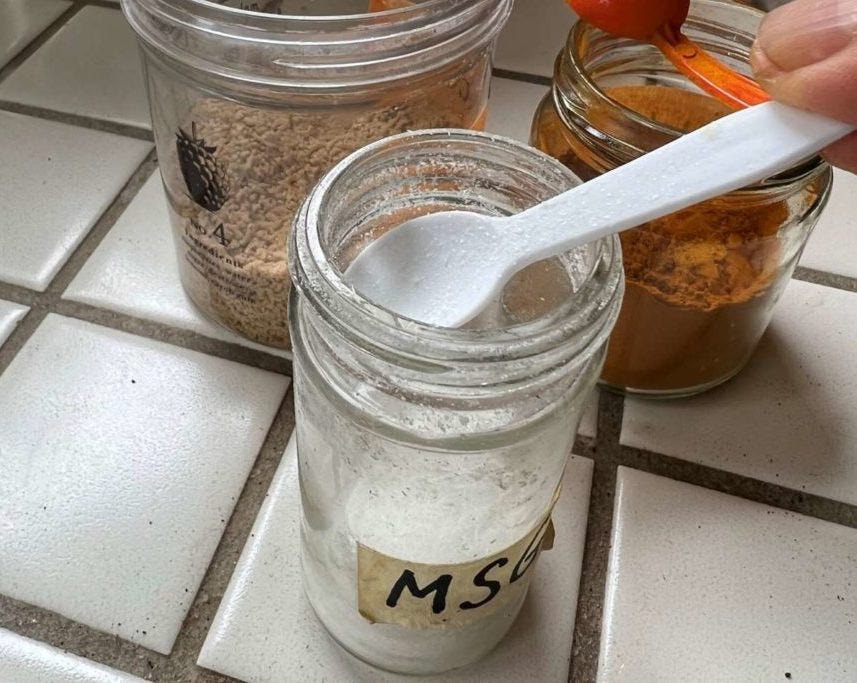

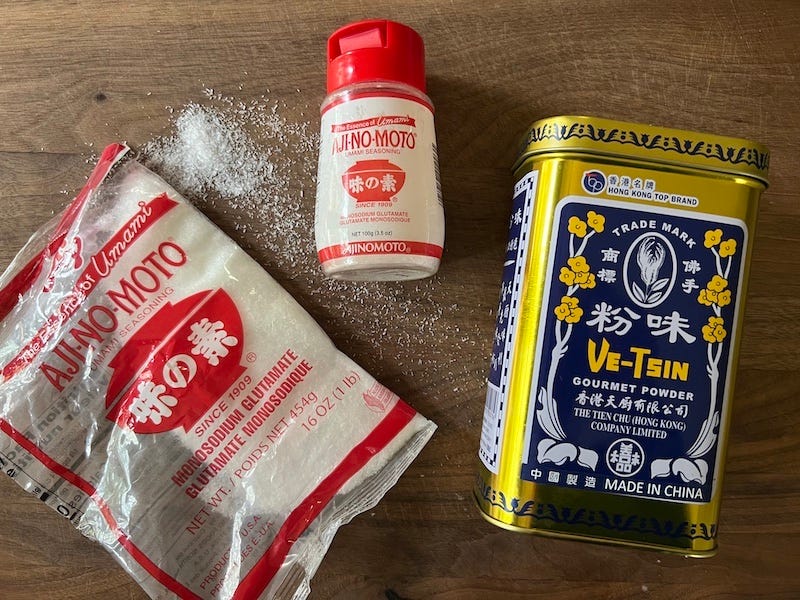
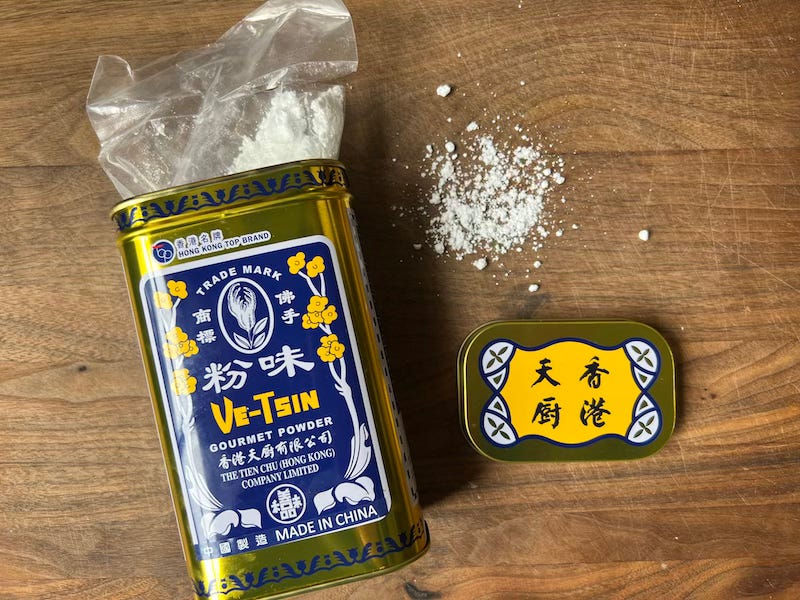
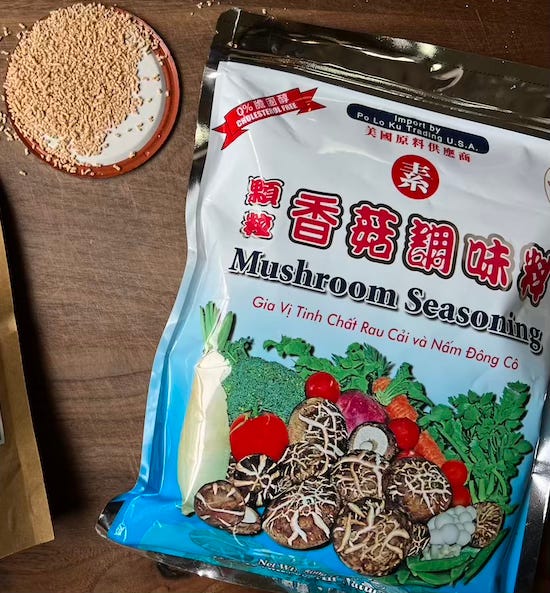


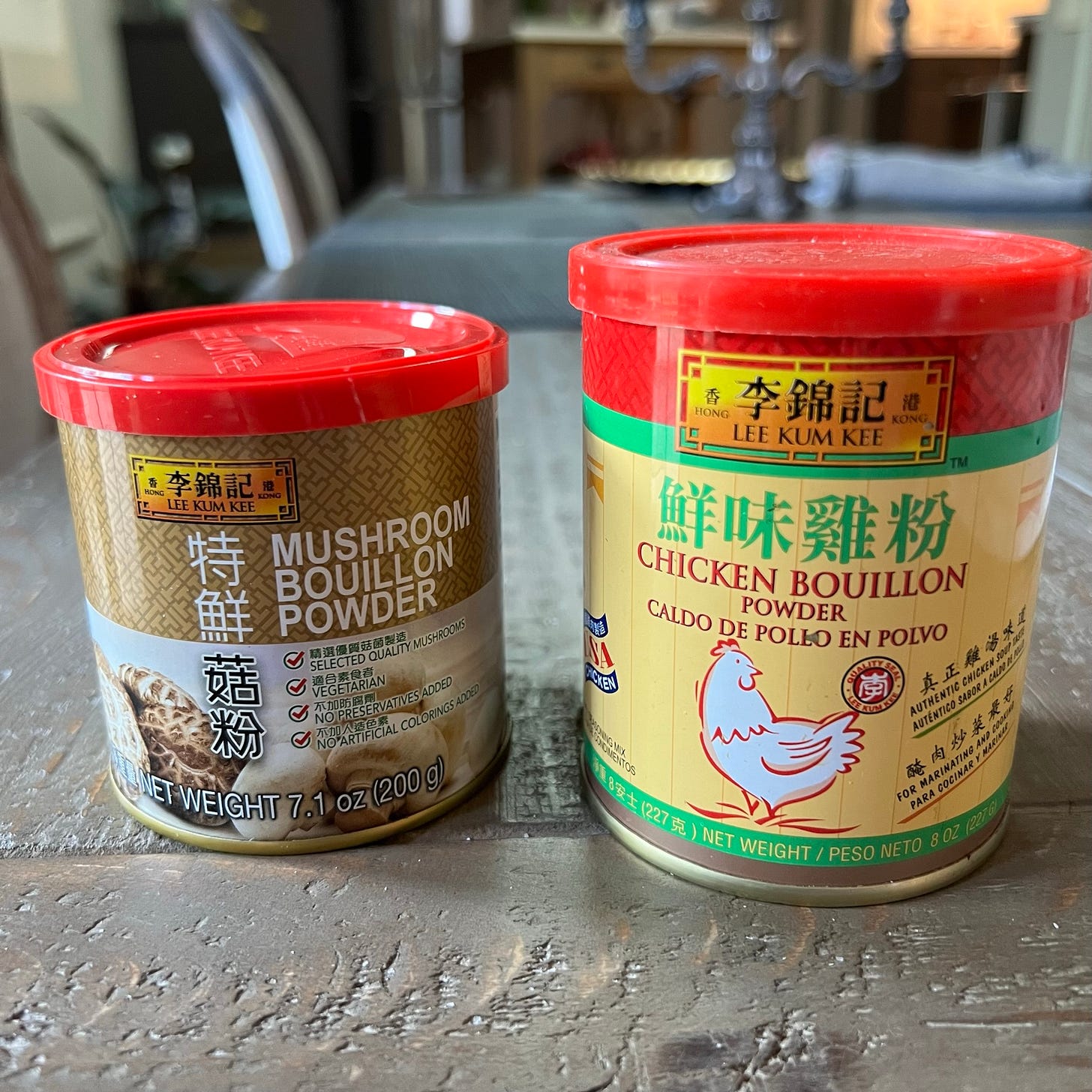

Andrea, thanks so much for untangling a very complicated subject. I feel much better about MSG after reading this.
Now I wish you would address the use of sugar in Asian (especially Southeast Asian) cooking--it sometimes seems ubiquitous to us non-Asians and somewhat troubling given dietary advice to avoid sugar as much as possible. Is it traditional? And if not, what does the modern use of sugar replace?
Practically a love letter to MSG. Nice. Thanks, Andrea. I have a can of Ve Tsin that serves as a fabulous accent piece. N ow, I'll start using the contents!